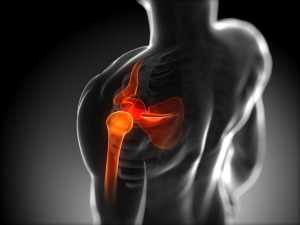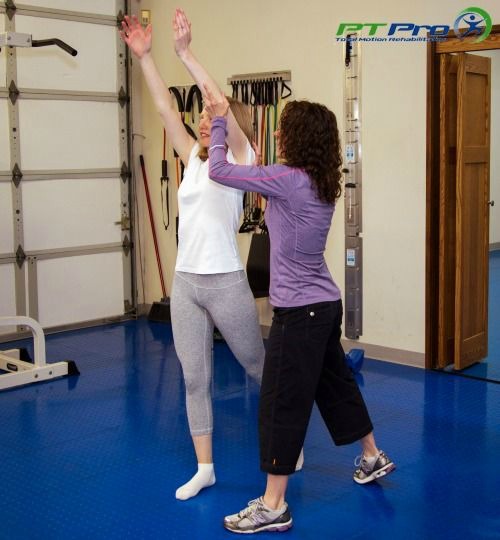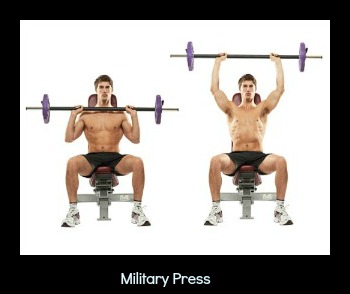As physical therapists, we see a number of different injuries; the most common being
shoulder injuries. Although a large percentage of shoulder injuries are sport related, there
are also many injuries that are due to either overuse or improper placement of the
shoulder during lifting. Many should injuries are preventable simply by learning how to
position your body correctly. At PT Pro, we not only help you recover from your injury
but also teach you how to take preventative measures to lessen the chance of reinjury.
The most common types of shoulder injuries we see are impingement syndrome, rotator
cuff inflammation (also known as tendonitis), rotator cuff tears, and labral tears. With
impingement syndrome, we see patients presenting with pain during over head activity of
the shoulder, such as painting, swimming, or tennis. Impingement is always due to faulty
mechanics. Impingement begins with minor restriction in the joint followed by increasing
pain, further inhibition of joint function, weakness in the joint, increasingly poor
mechanics and finally an increased level of pain. If not treated properly, impingement
syndrome could lead to more serious conditions such as tendonitis or bursitis.
Rotator cuff inflammation, more commonly known as tendonitis, is usually caused by
repetitive activities such as raking, painting or playing golf. It can also be caused by a
sudden injury to the shoulder or a minor impact to the joint. Incorrect posture and poor
warm up before exercising can lead to rotator cuff inflammation as well. Symptoms of
tendonitis are pain and loss of range of motion in the shoulder. If not treated properly,
tendonitis can lead to our next type of injury: rotator cuff tears.
Rotator cuff tears are serious yet common injuries. In 2008 alone, close to 2 million
people visited their doctor due to rotator cuff issues. The rotator cuff is “…a network of
four muscles that come together as tendons to form a covering around the head of the
humerus. The rotator cuff attaches the humerus to the shoulder blade and helps to lift and
rotate your arm.” (http://www.orthoinfo.aaos.org) When the rotator cuff is torn, it is incredibly painful and may also lead to another condition known as bursitis. Rotator cuff tears usually begin as a sort of fraying that occurs over time from daily use and then slowly progresses into a tear. RCTs may also be caused by sudden injury. While rest is important to recovery from an RCT, physical therapy will help the patient regain movement through a full range of motion, helping to keep the muscles of the shoulder from atrophying.
The final shoulder injury mentioned was the labral tear. A labral tear is the peeling back
of the cartilage by the biceps from a throwing motion or from trauma. As with the other
injuries mentioned, a labral tear leads to pain, loss of range of motion, and loss of
strength in the shoulder. If the tear is minor, physical therapy to strengthen the rotator
cuff muscles may be prescribed. In the case of a more severe tear, arthroscopic surgery
may be needed to repair the tear.
The goal here at PT Pro is to teach our patients the art of good mechanics and to build
strength and increase balance. This includes proper body placement before lifting, proper
posture during daily activities, and other effective ways to prevent injury. One technique
to practicing good posture is to focus on scapular positioning. Remembering to retract
your shoulders (pulling them down and back), helps you to maintain correct posture.
Shoulder injuries many times occur in the gym. A number of widely accepted exercises
are not exactly the best choices when considering shoulder maintenance. Here we list the
Top 6 Riskiest Shoulder Exercises:
· Dips
· Bench Presses
· Military Presses
· Lateral Pulls (behind the head)
· Pect Deck use
· Skull Crushers
These exercises do not promote the best positioning of the shoulder during movement
and could easily cause severe injury if not performed carefully. We also wanted to share
with you our Top 10 List of Healthy Shoulder Exercises.
· Exeternal Rotations
· Internal Rotations
· Scaption
· Frontal Raises
· Protraction (or push-up)
· Rows
· Scapular Depression
· Horizontal Abduction
· Bicep Curls
· Tricep Curls
These exercises offer more stabilization of the shoulder joint and can be done easily and
effectively.
As always, we encourage everyone to do their best to prevent injury during exercise or
activities of daily life. Shoulder injuries can be easily prevented if you take a few extra
moments to think about proper body placement and mechanics.







0 Comments